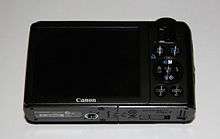Canon PowerShot S90
 | |
| Type | Digital Camera |
|---|---|
| Lens | 6.0–22.5 mm (35mm equivalent: 28–105 mm) f/2.0–f/4.9 |
| Sensor | 1/1.7" CCD |
| Maximum resolution | 3648 × 2736 (10.0 megapixels) |
| Flash | Internal |
| Shutter speed range | 1/1600 sec–15 sec |
| ASA/ISO range | ISO 80, 100, 125, 160, 200, 250, 320, 400, 500, 640, 800, 1000, 1250, 1600, 2000, 2500, 3200 |
| Exposure metering | Evaluative, Center-Weighted Average, Spot |
| Metering modes | Evaluative, Centre-weighted average, Spot (Centre) |
| Focus areas | TTL (9-point AiAF) 1-point AF (fixed to centre) |
| Focus modes | Single, Continuous (only available in Auto mode), Servo AF/AEl |
| Continuous shooting | Approx. 0.9 frame/s |
| Custom WB | Auto, Daylight, Cloudy, Tungsten, Fluorescent, Fluorescent H, Flash, Underwater, Custom |
| Rear LCD monitor | 3.0-inch Purecolor LCD II (TFT) appro. 461,000 dots |
| Storage | Secure Digital card |
| Battery | Canon NB-6L Li-Ion |
| Optional battery packs | AC Adapter Kit ACK-DC40 |
| Dimensions | 100.0 mm × 58.4 mm × 30.9 mm (W × H × D) |
| Weight | 175 g (6.2 oz) excluding battery |
| Made in |
|
The Canon PowerShot S90 is a high-end 10.0-megapixel compact digital camera originally announced in 2009. The PowerShot S90 is the successor of the Canon PowerShot S80.
The almost 4-year gap between the S80 and the S90, compared with intervals of 6 months to 1 year between prior versions, led to the line being popularly considered discontinued, and thus the S90 as a revival, rather than a strict successor.
Features
- 10.0 megapixels
- JPEG (Exif 2.2) support
- Raw image file format; one of few "point and shoot" cameras to have raw formatting. (Note: Raw format is not available in Auto, Low Light, and SCN modes. Raw is available in Program, TV (shutter priority), Av (aperture priority), Manual, and Custom modes)
- ISO sensitivity 80–3200 and auto. Low light mode can shoot up to ISO 12800.
- Wide-angle zoom lens 6.0–22.5 mm (35 mm equivalent: 28–105 mm)
- Full manual control
- Customizable Control Ring to control ISO, shutter speed, aperture, focus, or exposure compensation
- DIGIC 4 with iSAPS technology
- Video recording 640 × 480 at 30 frame/s, 320 × 240 at 30 frame/s
Reception
The S90 has received good,[1] in some cases excellent reviews,[2][3] with reviewers praising its image quality, small size, and ease of using manual mode, particularly due to its distinctive control ring. The fast (f/2) lens and the decision to reduce the pixel count (hence reducing noise; also found in the G11) are particularly cited.[4] The primary criticisms, beyond the general limitations of small sensor and small size, are that its ergonomics are lacking, and in particular that the rear dial moves too easily, changing exposure and often ruining photos.[5]
To address the ergonomic criticisms, third parties have developed a custom grip to make the camera easier to grip,[6] and a plastic ring to surround the control dial, making the dial less likely to be accidentally moved.[7][8]
Similar cameras
In the high-end compact camera market, its main competitor is the Panasonic Lumix DMC-LX3 (and the Lumix's sister camera, the Leica D-Lux 4);[1] one significant difference being that the S90 is significantly slimmer due to the fully collapsible lens, hence more portable.
The Canon PowerShot S95 was announced and released in 2010. It was designed as the successor to the Canon PowerShot S90 but both cameras are currently sold (as of January 2011).
The Canon PowerShot G series (As of June 2010, the G11) are similar in terms of target market, but feature a larger body and slower optics at the wide angle end.

A similar category to high-end compact cameras are mirrorless interchangeable lens cameras ("micros"), some of which are in a compact form factor (with a similar-sized body), such as the Panasonic Lumix DMC-GF1, Olympus PEN E-P1/E-P2, and Sony Alpha NEX-3. Micros differ however in being significantly larger (with lens attached), and significantly higher-end, featuring much larger sensors and interchangeable lenses.
References
- 1 2 Canon PowerShot S90 Review, by Simon Joinson, April 2010
- ↑ Canon S90: World's Best Pocket Camera, Ken Rockwell
- ↑ Canon S90 Review: It'll Never Leave My Pocket (Except When I'm Taking Pictures), Gizmodo
- ↑ Canon PowerShot S90, Imaging Resource
- ↑ s90 control dial: what reviewers say, Gail Bjork, December 25th, 2009
- ↑ Richard Franiec’s Custom Canon S90 grip, Gail Bjork, October 11th, 2009
- ↑ s90 Control Ring Solution, Gail Bjork, May 22nd, 2010
- ↑ Lensmate S90 Control Dial Solution
- Canon PowerShot S90 specifications at Canon UK
- Canon S90 Review
External links
![]() Media related to Canon PowerShot S90 at Wikimedia Commons
Media related to Canon PowerShot S90 at Wikimedia Commons
- Digicamhelp Blog » Canon s90, by Gail Bjork – blog about S90
- In-depth Canon S90 review at Enticing the Light (with depth-of-field and hyperfocal distance tables in Part 2): Part 1, Part 2 and Part 3
| Preceded by S80 |
Canon consumer digital camera September 2009–? |
Succeeded by S95 |